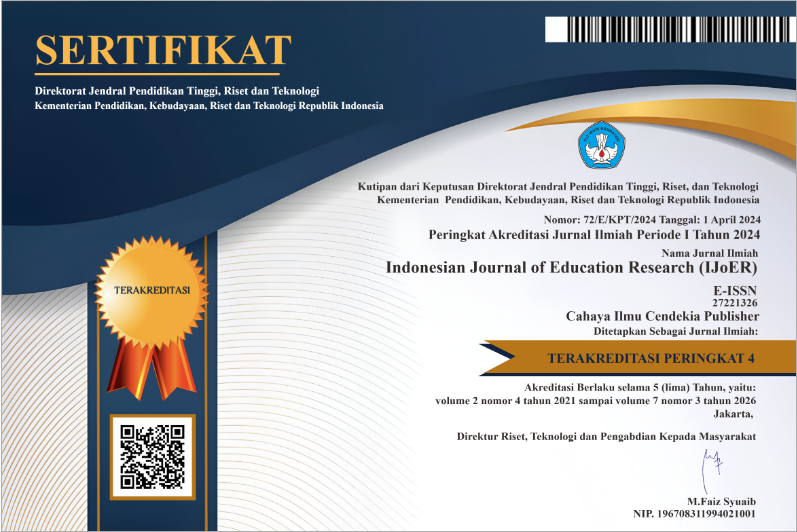The Old Stone House Site of Olak Kemang as a Source for Learning Indonesian History during the Age of Islamic Influence in Senior High Schools
Abstract
Purpose of the study: To find out how far the Old Stone House site has been used as a learning resource for Indonesian history under the influence of Islam for education and students.
Methodology: The method used is a qualitative method with a descriptive text approach. As for data collection techniques using qualitative data collection techniques in the form of interviews, observation and documentation.
Main Findings: The results of the study show that there are several heritage buildings of the Jambi sultanate at the time of spreading Islamic teachings and during the Dutch colonial period which had Indonesian history during the Islamic Influence era.
Novelty/Originality of this study: The Islamic legacy in the Olak Kemang sub-district is very important to be used as a learning resource so that learning Indonesian history under Islamic influence is more enjoyable, challenging, and meaningful.
References
D. M. Napitupulu., F. Muchlis., and E. Adriansyah, “Analysis of provision of green open space in jambi city,” International Journal of Research in Vocational Studies (IJRVOCAS), vol. 2, no. 3, pp. 78-82, 2022.
M. D. Izhar., M. B. Butar., F. Hidayati., and R. Ruwayda, “Predictors and health-related quality of life with short form-36 for multidrug-resistant tuberculosis patients in Jambi, Indonesia: A case-control study,” Clinical Epidemiology and Global Health, vol. 12, 100872, 2021.
R. Wardiah., and M. Syukri, “Spatial analysis to identify hotspots of covid-19 incidence in jambi municipality indonesia,” Indonesian Journal of Global Health Research, vol. 5, no. 1, pp. 49-60, 2023.
M. R. Winanda., W. Wadiyo., and S. S. Sinaga, “Revitalization of islamic values of kompangan traditional music at the jambi cultural arts institution in seberang city in jambi province,” Catharsis, vol. 11, no. 3, pp. 263-271, 2022.
R. Seprina, Pemanfaatan cagar budaya rumah batu olak kemang di jambi kota sebrang sebagai sumber belajar bagi mahasiswa pendidikan sejarah universitas jambi,” KRINOK: Jurnal Pendidikan Sejarah dan Sejarah, vol. 1, no. 2, pp. 119-133, 2022.
Y. I. Ambarwati., and N. Agustiningsih, “Arsitektur masjid al-ikhsaniah olak kemang 1880-2010,” Istoria: Jurnal Ilmiah Pendidikan Sejarah Universitas Batanghari, vol. 5, no. 1, pp. 32-40, 2022.
W. Sanjaya, Perencanaan dan Desain Sistem Pembelajaran. Jakarta: Rencana Prenada Media Grup, 2018.
R. Rayandra, Kreatif Mengembangkan Media Pembelajaran. Jakarta: Gauna Persada (GP) Pres Jakarta.
M. Z. A. Anis., H. P. N. Putro., H. Susanto., and K. P. Hastuti, “Historical thinking model in achieving cognitive dimension of indonesian history learning,” PalArch's Journal of Archaeology of Egypt/Egyptology, vol. 17, no. 7, pp. 7894-7906, 2020.
Á. Chaparro-Sainz., and R. A. Rodríguez-Pérez, “Perceptions on the use of heritage to teach history in Secondary Education teachers in training,” Humanities and Social Sciences Communications, vol. 7, no. 1, pp. 1-10, 2020.
M. Sadeghi, “A shift from classroom to distance learning: Advantages and limitations,” International Journal of Research in English Education, vol. 4, no. 1, pp. 80-88, 2019.
S. Sugiyono, Metode Penelitian Kombinasi (Mixed Methods). Bandung: Alfabeta, 2008
L. Moleong, Metodologi Penelitian Kualitatif. Bandung: PT Remaja Rosdak.
A. Aman, Model Evaluasi Pembelajaran Sejarah. Yogyakarta: Ombak, 2011
P. Inguva., P. Shah., U. Shah., and C. Brechtelsbauer, “How to design experiential learning resources for independent learning,” Journal of Chemical Education, vol. 98, no. 4, pp. 1182-1192, 2021.
F. Fitriyani., H. P. N. Putro., and M. Mutiani, “Activities at the Banjarbaru tomato creation house as a learning resources on social studies,” The Kalimantan Social Studies Journal, vol. 2, no. 2, pp. 127-140, 2021.
Copyright (c) 2023 Pauzan J, Hardina Hardina

This work is licensed under a Creative Commons Attribution-NonCommercial 4.0 International License.
Authors who publish with this journal agree to the following terms:
- Authors retain copyright and acknowledge that the Indonesian Journal of Education Research (IJoER) is the first publisher licensed under a Creative Commons Attribution 4.0 International License.
- Authors are able to enter into separate, additional contractual arrangements for the non-exclusive distribution of the journal's published version of the work (e.g., post it to an institutional repository or publish it in a book), with an acknowledgment of its initial publication in this journal.
- Authors are permitted and encouraged to post their work online (e.g., in institutional repositories or on their website) prior to and during the submission process, as it can lead to productive exchanges and earlier and greater citation of published work.






.png)
.png)




















